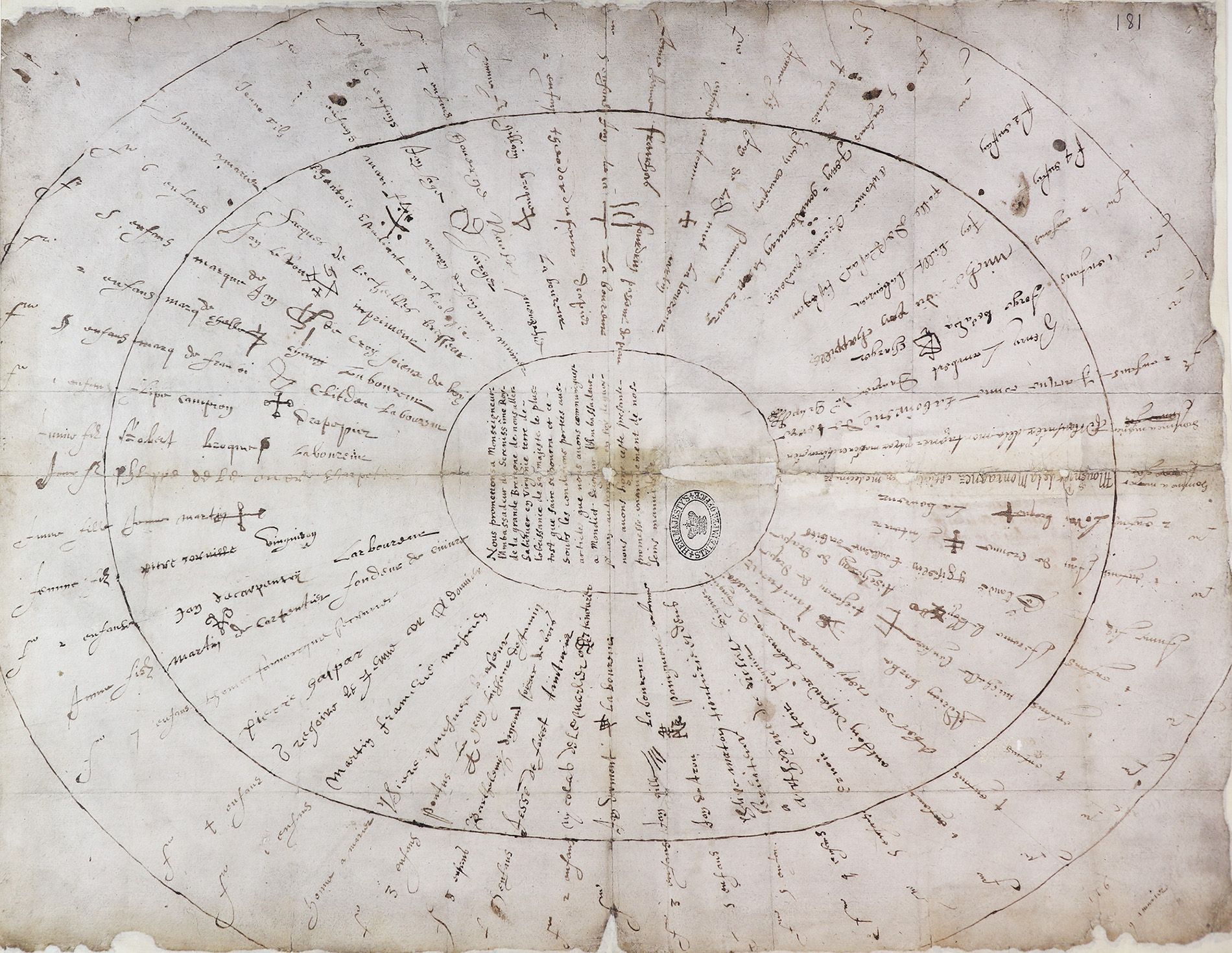
A ‘round robin’ from Walloon emigrants. Catalogue Ref: MFQ 1/565
A round robin was a document written in circular fashion to disguise the order in which it was done. This document is a promise by certain Walloons and French to go and inhabit Virginia, a land under obedience of the Kings of Great Britain’. 1621.
Walloons: French-speaking Protestants from Wallonia, the southern area of Belgium
French Protestants: Huguenots.
Transcript (centre of document)
French:
Nous promettons a Monseigneur- l’Ambassadeur de sérénissime Roy- de la grande Bretugne de nous aller- habituer en Virginie terre de- l’obeissance de sa majeste. Le plus= tost que faire [damaged, unreadable] et ce soubs les conditions portées aus- articles que nous avons communiques-a Mondid seigner l’Ambassadeur et non autrement en foy deqnor nous avons signe c’este presante fromesse unanimement de nos seins [damaged, unreadable]
English translation:
We promise to Your Grace, Illustrious Royal Ambassador of The Most Serene King of Great Britain to go and inhabit in Virginia, a land under his Majesty’s sovereignty, as soon as conveniently may be, under the scope of the conditions to be carried out in the articles that we have communicated to the Ambassador, and not otherwise, on the faith of which we have unanimously [give consent of all] signed this present with our sign manual.
Transcript (around the edge of the document – starting centre left along the document crease line)
Note: The document contains 227 signatures including 55 men, 41 women, 129 children, and 2 servants. Their professions include surgeon, woollen draper, tiller of the earth, weaver, printer, shoemaker, and glass maker, and others. On the outer rim on the circle, we know if each male signatory has a wife (F), and the number of children they have (enfants). The names with a * have only signed their marks.
F *Jan Damont, labourer
F 3 children *Jan Gille, labourer
F 5 children *Jan de Trou, wool carder [prepared wool for spinning]
F 5 children Philippe Maton, dyer and two servants
F 4 children Anthoine de Lielate, vinedresser [pruner and grows vines]
F 5 children Ernou Catoir, wool carder
F 1 child Anthoin Desendre, labourer
F 4 children Abel de Crepy, shuttle worker [textile worker]
F 4 children Adrian Barbe, dyer
F 1 child Michel Leusier, cloth weaver
F 4 children *Jerome Le Roy, cloth weaver
Young man *Claude Ghiselin, tailor
F 1 child *Jan de Crenne, glass maker[?]
F 2 children *Louis Broque, labourer
Marrying man Monsieur de la Montagne, medical student
Marrying man Monsieur de la Montagne, apothecary and surgeon
F 2 children Jacque Conne, tiller of the earth
F Henry Lambert, woolen draper; [dealer in cloth] wife
F 1 child *George Béava, porter
F 2 children Michel Du Pon, hatter
F 4 children Jan Bullt, labourer
F 2 children Paul de Pasar, weaver
F Antoine Grenier, gardener
F 5 children Jean Gourdeman, labourer
F 4 children Jean Campion, wool carder
Young man *Jan De La Met, labourer
F 1 child *Antoine Martin
Young man Francois Fourdrin, leather dresser [prepared animal skin after tanning]
F 5 children *Jan Leca, labourer
F 2 children Theodore Dufour, draper
Young man *Gillain Broque, labourer
F 4 children George Wauter, musician
F 6 children *Jan Sage, serge (wool) maker
F 2 children Marie Flit, in the name of her husband, a miller
Young man P. Gantois, student in theology
Marrying man Jacques de Lecheilles, brewer
F 6 children *Jan Le Rou, printer
F 5 children *Jan de Croy, sawyer [timber worker]
F 2 children *Charles Chancy, labourer
F 5 children *François Clitdeu, labourer
F 1 child *Phillipe Campion, draper
Young man *Robert Broque, labourer
Young man Phillipe De le Mer, carpenter
Young girl *Jeanne Martin
Young man Pierre Cornille, vine-dresser
F 2 children Jan de Carpentry, labourer
Young man *Martin de Carpentier, brass founder [maker of objects from brass]
F 7 children Thomas Farnarcque, locksmith
Pierre Gaspar
F 4 children *Gregoire Le Jeune, shoemaker
F 1 child Martin Framerie, musician
Marrying man Pierre Quesnée, brewer
F 3 children Pontus Le Gean, bolting-cloth weaver
F 8 children *Barthelemy Digaud, sawyer
F 5 children Jesse de Forest, dyer
F 2 children *Nicolas De la Marlier, dyer
- Why do you think this document was written in French? [See centre.]
- Who is the ‘Most Serene King of Great Britain’ responsible for the first colonisation of America in 1607?
- To which location do the French Protestants and Walloons hope to emigrate?
- The document is in the unusual shape of a ‘round robin’, which means the signatures are arranged in a circle to disguise the order in which they have signed. Why might the people signing the document have done this?
- Spot the symbols in the document. These are signature marks. Some of the people signing the document, including many labourers, have used a mark for their proof of signature, with someone else writing their name in full. Why do you think they might have done this?
- What does this suggest about the people who wanted to settle in Virginia?
- How could these settlers develop the importance of the colony?
